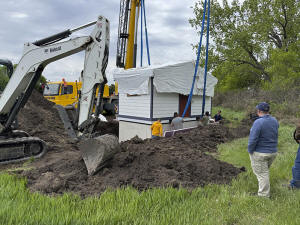|
The North Dakota group's goal of replacing pit toilets with
flush units may seem like a humble aspiration to some, but it's
an important milestone, said Chris Dorfschmidt, a historic sites
manager.
“A lot of our sites are kind of in the middle of nowhere. As I
like to put it, history didn't happen where it's convenient,” he
said. “Because of that, if you've driven all the way out there,
and that's the best we can do to kind of accommodate you, it's
not the most pleasant experience.”
North Dakota has 60 state historic sites — everything from
museums and an underground nuclear launch facility to plaques
mounted on boulders in fields.
“All of our sites, they really do help share a story of us as a
state,” Dorfschmidt said.
Two other facilities are slated to be finished by June 30: at
Whitestone Hill, the site of a deadly 1863 attack by U.S. troops
against Native Americans; and Fort Buford, a military fort near
the Missouri-Yellowstone river confluence.
The Historical Society also is eyeing the Chateau de Mores for
flush toilets. The wealthy Marquis de Mores built the 26-room
home in 1883 near Medora, a present-day tourist town in the
state's scenic Badlands where a young President Theodore
Roosevelt once roamed.
Less-visited sites that aren't staffed likely won't receive a
restroom upgrade, which costs about $150,000 each.
At the Welk Homestead, about 50 miles (80.5 kilometers)
southeast of Bismarck, workers matched the color scheme of the
restroom to the house and farm buildings, including interior
colors.
“We made it to fit into the site and harmonize with the site and
just be a pleasant part of the experience,” Historic Sites
Manager Rob Hanna said.
All contents © copyright 2025 Associated Press. All rights
reserved |
|




